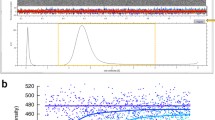Abstract
A fluorescence detection system was developed for the analytical ultracentrifuge Spinco model E. Fluorescence is excited by a laser beam which is focussed into the cell and illuminates an area with a dimension of 60 μm in radial direction. For scanning the laser beam is moved in radial direction. After passing the cell, the laser beam is quenched by a carbon light trap and a set of optical filters. Fluorescence emission intensity is monitored by a photomultiplier located behind the light trap and the set of filters. The sensitivity of the detection system was tested by applying it to the sedimentation analysis of proteins and nucleic acids. Bovine serum albumin (BSA) was covalently labelled with the fluorescence-dye fluorescein-isothiocyanate (FITC), and its sedimentation coefficient could be determined even if BSA was analyzed in a concentration as low as 10−10 M. Nucleic acids were labelled non-covalently by the intercalating dye ethidium bromide. Only 8 ng RNA were needed for the determination of the sedimentation coefficient. The particular advantages of the fluorescence detection system were exploited for the establishment of a new method for quantitative virus detection. To tobacco mosaic virus (TMV) a monoclonal anti-TMV antibody from mouse was bound, and to this a second, anti-mouse antibody that carried the fluorescence-label FITC was attached. Either by UV-irradiation or by incubation with glutaraldehyde, the first antibody was covalently crosslinked to TMV, and the second antibody to the first. In CsCl density centrifugation with fluorescence detection as little as 3.2 ng virus/80 μl or 6×108 virus particles/ml were recorded in a well expressed band at the corresponding buoyant density. Tenfold lower concentration would result still in a significant band. The sensitivity compares well with those of the most advanced techniques from immunology. Due to the specific labelling of viruses by antibodies it will be possible to carry out quantitative physical characterization of virus containing samples without purifying the virus. Future applications of the fluorescence detection system and of the virus detection technique are discussed.
Similar content being viewed by others
References
Schachmann HK (1959) Ultracentrifugation in Biochemistry. Academic Press, New York
Neuberger A, van Deenen LLM (eds) (1988) Modern Physical Methods in Biochemistry. Elsevier, Amsterdam
Lewis MS, Weiss GH (eds) (1976) Fifty Years of the Ultracentrifuge. North-Holland Publishing Company-Amsterdam, New York, Oxford
Goodman TC, Nagel L, Rappold W, Klotz G, Riesner D (1984) Nucleic Acids Res 12:6231–6246
Rappold W (1986) Ph D thesis, Universität Düsseldorf
Kapahnke R, Rappold W, Desselberger U, and Riesner D (1986) Nucleic Acids Res 14:3215–3228
Crepeau RH, Conrad RH, Edelstein SJ (1976) Biophys Chem 5:27–39
Fischer P, Kreuzaler F, manuscript in preparation
Clarke MF, Adams AN (1977) J gen Virol 34:475–483
Schoemaker HJP, Schimmel PR (1974) J Mol Biol 84:503–513
Klaff P (1987) Ph D, thesis, Universität Düsseldorf
Floßdorf J (1980) Makromol Chem 181:715–724
Tanford C (1961) Physical Chemistry of Macromolecules. J Wiley, New York
Matthews REF (1982) Intervirology 17:158–159
van Regenmortel MHV, Hardie G (1976) Immunochem 13:503–507
Smith LM, Fung S, Hunkapiller MW, Hunkapiller TJ, Hood LE (1985) Nucleic Acids Res 13:2399
Krauss G, Pingoud A, Boehme D, Riesner D, Peters P, Maass G (1975) Eur J Biochem 55:517–529
Koenig R, Lesemann DE, Burgermeister W (1984) Phytopath Z 111:244–250
Büttner C, Nienhaus F (1989) Eur J For Path 18:47–53
Frenzel B (1985) In: Kortzfleisch GV (eds) Waldschäden Theorie und Praxis auf der Suche nach Antworten. R Oldenburg Verlag, München, Wien, pp 61–80
Author information
Authors and Affiliations
Rights and permissions
About this article
Cite this article
Schmidt, B., Rappold, W., Rosenbaum, V. et al. A fluorescence detection system for the analytical ultracentrifuge and its application to proteins, nucleic acids, and viruses. Colloid & Polymer Sci 268, 45–54 (1990). https://doi.org/10.1007/BF01410422
Received:
Accepted:
Issue Date:
DOI: https://doi.org/10.1007/BF01410422




